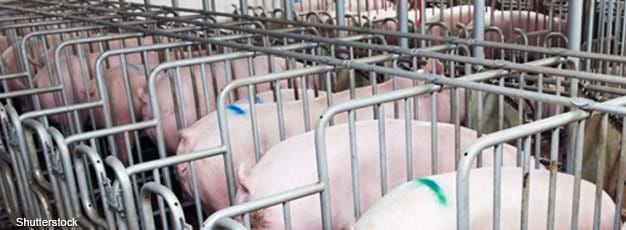Production Contracts May Help Small Hog Farms Grow in Size

In the U.S. hog sector, production contracts—under which farm operators agree to raise hogs owned by contractors—are becoming increasingly common: the share of market hogs grown under a production contract increased from 5 percent in 1992 to over 70 percent in 2009. Under a typical contract to finish hogs, the farm operator provides labor, equipment, and housing while the contractor provides feed, feeder pigs, and veterinary and transportation services. The growth in the use of production contracts has been accompanied by pronounced increases in the size of farms producing hogs. Between 1992 and 2009, the average number of market hogs sold or removed from contract per farm yearly increased from 945 to 8,390 head. Recent ERS research examines whether production contracts have facilitated this growth in hog farm size.
Using Census of Agriculture data, farm size changes of feeder pig-to-finish hog operations that used or adopted a production contract were compared to those that produced independently. Feeder-to-finish operations are those on which feeder pigs (weighing 30-80 pounds) are obtained from outside the operation, either purchased or placed under contract, and then finished to a slaughter weight of 225-300 pounds. In the three smallest farm size categories considered, operations using production contracts in 2002 grew more in size by 2007 than operations that did not initially use production contracts. In contrast, the largest farms (at least 5,000 head) with production contracts grew no faster than those without contracts.
A similar story emerges when comparing the growth of farms that started using a contract between 2002 and 2007 to farms that remained independent over this period. Among smaller scale operations not using a production contract in 2002, those that started contracting by 2007 experienced faster growth than operations that never used a contract. In contrast, for larger farms there was no significant difference between contract adopters and non-adopters.
There are several possible reasons why production contracts may have helped smaller-scale operations expand production. By reducing producer input expenditures, production contracts may have allowed operators with limited financial resources to operate on a larger scale. Production contracts may have also allowed small-scale producers to obtain more credit for facility expansion than they would have been able to otherwise if such contracts substantially reduce farm income risk. Alternatively, contracts might facilitate the transfer and adoption of new production technologies that allow smaller operations to grow by producing more efficiently and profitably. In contrast, for large farms, neither contract use nor adoption was associated with an increase in the scale of production. It is likely that beyond a certain size, economies of scale in hog production are limited. Hence, large-scale operations would not need to take advantage of scale-enhancing benefits provided by contracts.
| Initial farm size (head removed in 2002) | No contract | Adopted contract | ||
|---|---|---|---|---|
| All continuing farms (production contracts in 2002) | ||||
| Small (100-999) | 57.0 | 82.9 | ||
| Medium (1,000-2,499) | 25.1 | 49.2 | ||
| Large (2,500-4,999) | 11.2 | 24.6 | ||
| Very large (5,000+) | 8.9 | 7.0 | ||
| Continuing farms without production contract in 2002 (adoption of production contracts by 2007) | ||||
| Small (100-999) | 43.5 | 172.1 | ||
| Medium (1,000-2,499) | 11.6 | 91.9 | ||
| Large (2,500-4,999) | 8.1 | 26.4 | ||
| Very large (5,000+) | 9.4 | 7.1 | ||
| A continuing farm is one that sold or removed hogs in 2002 and 2007. Only feeder to finish operations—those that specialize in raising feeder pigs (weighing 30-80 pounds) to market weight (typically 225-300 pounds)—are analyzed. Source: USDA, Economic Research Service using 2002 and 2007 Census of Agriculture data. |
||||
U.S. Hog Production From 1992 to 2009: Technology, Restructuring, and Productivity Growth, by William D. McBride and Nigel Key, USDA, Economic Research Service, October 2013
“Production Contracts and Farm Business Growth and Survival”, Journal of Agricultural and Applied Economics, Vol. 45, No. 2: 277–293, May 2013

